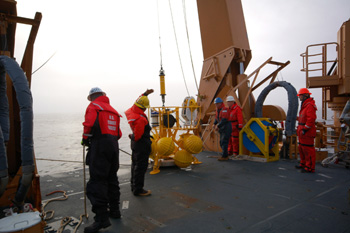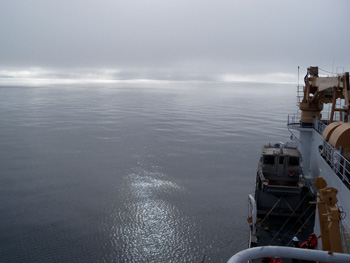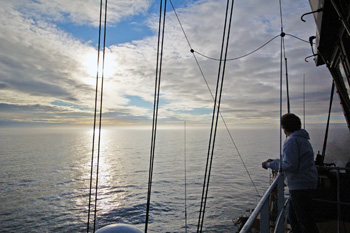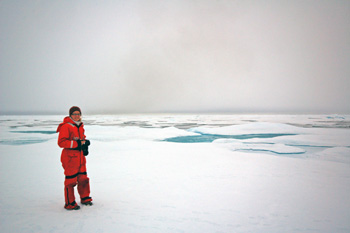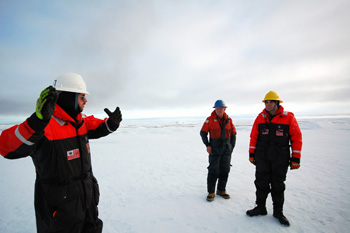Dear Ms. Eves, thank you for the questions. I'm looking forward to learning the answers to some of these myself. --Pat Keoughan QUESTION 1 HOW DOES THE ICT/HARD DRIVE EQUIPMENT COPE WITH THE VIBRATIONS ON THE BOAT? Answered by Eric Burns, Coast Guard Internet Technician: The computers, hard drives and servers do surprisingly well. They are surviving the vibrations of the Healy without problems. Some large assemblies of hard drives and servers are mounted on special racks which have shock absorbers under them. QUESTION 2 WHAT IS THE FOOD LIKE? Answered by Pat Keoughan, Outreach: I've polled my Outreach Team and we agree that the food is pretty good. There is a lot of variety. For example, we had tacos for lunch one day and Chinese food for dinner the next. Like in school cafeterias, the "Mess" cooks don't make types of food that only a few people like. You can ask for as much or as little as you want. We have the usual favorites like spaghetti and sauce, roast beef with potatoes, cheeseburgers, lasagna and macaroni and cheese. There are always choices of types of potatoes and/or rice, vegetables, choices of meat or veggie entrees, salad, rolls or garlic bread and especially delicious desserts. As you might guess, the desserts are many peoples' favorite part of the meal. We've been served all kinds of homemade goodies such as cookies, pecan and key lime pie, red velvet cake, and lemon bars along with other choices like yogurt, jello and pudding. If you wander into the "Mess" area between meals you sometimes find leftover muffins or cookies left out for between meal snackers or for those who have missed meals. You can always get coffee, tea, juices and sodas to drink. Cereal, pop tarts, snacks like hard candies, small bags of Oreos or salty finger food are available 24/7. Along with the food we enjoy the "Mess" cooks who are friendly serving us our food along the cafeteria line, eat and chat with us and ask for our favorite meals to plan next week's menus. As a Lean Cuisine/microwave cook at home, this is heaven! QUESTION 3 HOW LONG ARE YOU WORKING FOR? Answered by Pat Keoughan: There are several ways to answer this. I, personally, am working 8 to 10 hours a day now that we are receiving student questions daily. Part of that time is watching, listening and reading to learn as much as I can about what is going on with the science aboard the Healy, in order to do my best getting your questions answered. Some of the scientists are not working by the clock, but doing what they have to do to get their science project completed during the cruise. They may have slow days and other days, for example, if they have a mooring that is being deployed at some point during the cruise, when they get little if any sleep. The CTD crews are on a watch system where they work for 12 hours, then are off for 12 hours. This way we can (and do) perform CTD casts around the clock. The only limitations we have is that the mooring deployments need to be done during daylight hours, and he sea state can’t be too rough. The Healy has not stopped sailing since we got onboard except for instrument deployment or retrieval. The Coast Guard has its own watch system, rotating the crew so they have work time and free time. The Healy sails all night, every night. Our cruise started on September 6, 2010 and will end September 27th, 2010.
Answered by David Leech, Mooring Technician: The simple answer is "No". Hydrophones are electroplated ceramics typically in a thin oil (mineral oil) and are used in the ocean, which never gets colder than freezing (-1.8 degrees C in these salty waters). However, some of the hydrophones are used on acoustic release mechanisms and one manufacturer used a grease on the release levers and pivots that would freeze at these temperatures. Last year we had to "drag" for these moorings across the bottom and we now do not use any grease that has not passed a freezer test. Plastic is a cheap and easily machinable material to make parts for our moorings. Most plastics are fine once in the water but are very brittle on deck awaiting deployment when it is very cold. We have been fortunate that it has been very nice weather for us this trip. Another more interesting problem. We will be deploying a meteorological station on the pack ice in a few days. It will see very cold temperatures over its life (up to a year we hope) but it may not hold up to polar bears. They are very inquisitive and like to test our construction techniques.
Answered by Pat Keoughan: The temperatures we've been experiencing were posted before I received your questions. You will find answers to that part of your question in Blakely School's question 4, Sidcot School's question 4, and Morse Pond School's question 5. The weather has mostly consisted of fog, either wrapped around the ship or in the distance in fog banks. Above it can be blue skies or cloudy. There has been very little precipitation, just a light sprinkle once or twice (although today it snowed!). We have had a lot of windy days so the wind chill factor has been a big part of the weather we've been experiencing. Checking online just now I see, from the meteorological instruments aboard, that the temperature is 39.5 degrees F (3.9 degrees C) and the wind chill is 28.7 degrees F (-1.81 degrees C). (Friday, 9/17/10, 8:30PM). QUESTION 6 HOW DID YOU BECOME INVOLVED IN THIS EXPEDITION? Answered by Pat Keoughan: During my last year teaching in the fall of 2008, I was a teacher, just like Ms. Eves, with a class of fifth graders. Dr. Bob's son was in one of my two science classes, so I was invited to follow the website of his cruise to the Irminger Sea aboard the R/V Knorr, just like you are following this one. I saw it as a wonderful, unique experience for my students to learn about part of our science curriculum using the website and asking our questions. (To see the Irminger Sea website, which is similar to our Vanishing Arctic website, click here.) I retired at the end of that school year after 40 years of teaching. This past June I received an e-mail from Dr. Bob asking if I wanted to join this cruise as a former teacher and one who already knew how the website and e-mail questions work. It was a lot of work for Dallas Murphy to write his daily journal entry and coordinate it with the people taking photos and video AND get all the student questions answered. Now Dallas gets to spend more time on what he does best, and I am responsible for finding answers to the questions from our classes. Being retired I was free to go to sea in September. It took me about one second to say, "YES!"
Answered by Pat Keoughan: I was standing on the shore of the Beaufort Sea in Barrow, Alaska waiting for my turn (the last flight) to be helicoptered onto the Healy. I could see the Healy about three miles off shore and it looked tiny so far away. Once onboard I was relieved to find our cabin had plenty of room and had a porthole so we could look outside. This ship is so huge there are many parts of it I haven't seen yet. I can always get out on deck to breathe the fresh, Arctic air and look at the ever changing sky, sea and weather. Another aspect of this is that we are all busy with our work, getting to meals, doing laundry and making our beds (if we do) , enjoying a book or e-mail or movie that we don't have time to think about being on a small boat in a big sea. The Healy does not feel like a confined space when you are living and working aboard her. QUESTION 8 HOW LONG COULD YOU SURVIVE IN THE WATER? Answered by, MST2 Owen Dick: (Owen Dick is one of the Healy Coast Guard personnel whose job is to work with the science group aboard. MST stands for Marine Science Technician.) The answer to your question is that with the sea temperature at 2.5 degrees centigrade, 15-30 minutes would be the maximum amount of time some one could survive in these Arctic waters. A big factor in survival would be whether or not the person was wearing a personal flotation device (PFD) and if so, what kind. Without a PFD, drowning can occur faster due to exhaustion. I have attached a link to a page that explores this question in depth. I think it's a great thing to educate kids about hypothermia. As you will find from the web, page hypothermia can even occur in warmer waters so everyone who goes on the water should be aware.
Last updated: September 29, 2010 | |||||||||||||||||||||||
Copyright ©2007 Woods Hole Oceanographic Institution, All Rights Reserved, Privacy Policy. | |||||||||||||||||||||||
